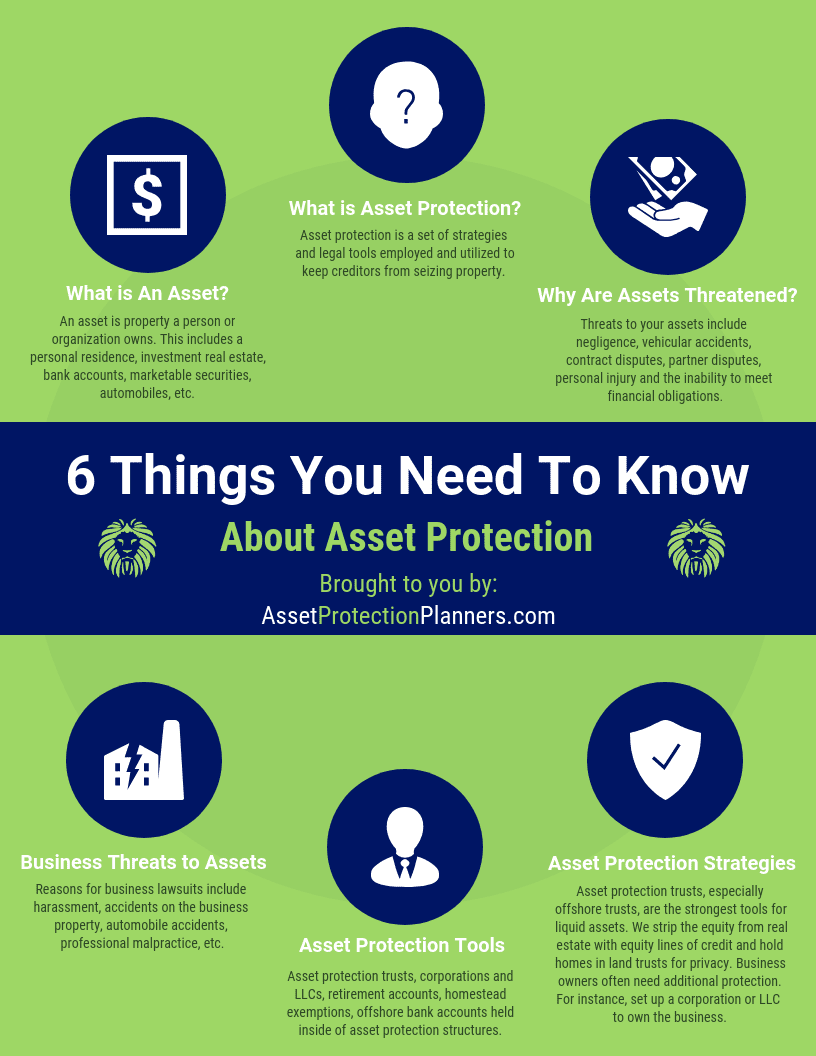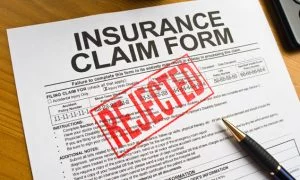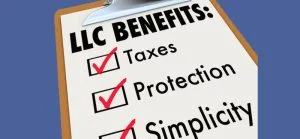This article will examine the top six asset protection strategies. You can follow these steps when creating your asset protection plan to help you understand your options. No matter what is coming down the road toward your or your business, keep your assets where they should be – with you.
Legal risks are all around us. You can get into a car wreck where someone sues you for more than the limits of your insurance policy. Someone can falsely accuse you or one of your employees of sexual harassment, discrimination or wrongful termination. We have had clients who were blindsided when a spouse suddenly announced that he or she wanted a divorce, out of the blue.
So, to keep your assets you need to know your options, and to act early. To do that, it is best to start asset protection planning now. If you’ve never created a plan before though, it can seem like there are a lot of options. Where can you start?

What is Asset Protection?
Most people need an asset protection plan, but what is that? Asset protection definition is the adoption of strategies for safeguarding one’s wealth. As part of financial planning, the goal of asset protection is to protect one’s assets from creditor claims. Individuals and businesses use asset protection plans to limit the access creditors have to certain valuable assets. At the same time, it is important to operate within the confines of debtor-creditor law. As a business owner you can sleep better at night when you are lawsuit proof.
As a legal measure, asset protection plans insulate assets while avoiding illegal practices such as concealment, contempt, fraudulent transfer, tax evasion, or bankruptcy fraud. Although anyone can create an asset protection plan, it is the preferable choice for those with significant assets to protect. Some common methods for asset protection include a domestic or offshore asset protection trust, domestic limited liability company (LLC), and an offshore LLC.
Some assets are already exempt from creditors. Qualified retirement plans are protected from creditors under the United States federal bankruptcy and ERISA (Employee Retirement Income Security Act of 1974) laws. There are several states that do not protect IRAs or give very weak IRA protection, such as California. Many states do not protect Roth IRAs at all. These laws do not, however, protect retirement accounts from divorce. So, we need to employ additional measures.
Some states also allow exemptions for a specified amount of home equity in a primary residence. Some protect personal property, such as clothing. Each state has laws to protect owners of corporations and limited liability corporations (LLCs) from liability within the entity.
Let’s now cover some general rules for protecting your assets from lawsuits.

1. Start Planning Before a Claim Occurs
The best asset protection security comes from starting early. Once you know that a lawsuit or judgement creditor is coming, it’s too late for some (but not all) asset protection plans. Why? As The Balance explains, each state has laws that protect judgement creditors against those who make asset transfers with the intent to hinder, delay, or defraud a creditor. The court will classify these late transfers as fraudulent transfers. Don’t worry, in this case, we are talking about a civil matter not a criminal one. What happens when someone transfers assets out of their name after someone has started a claim against them? The court will likely order them to reverse the transfers and turn over the assets to pay the creditor
That is why offshore asset protection plans work so well. Offshore trusts and your trustee/law firm can step in to protect you. They are outside of your local court’s jurisdiction. So, it does not matter if the courts order the assets returned. The trustee/law firm offshore will not comply. Since it is them, and not you, failing to comply, you typically get off scot-free.
It’s never too early to start protecting yourself from lawsuits. Starting your asset protection plan early helps ensure that you’re protected when claims arise. Repositioning your nonexempt assets as assets that are out of reach of a creditor’s claims figuratively turns them into exempt assets.

2. Create a Multi-Layered Plan
Being fully protected against creditors and lawsuits means having multiple lines of defense. It isn’t enough just to have a trust or LLC alone. As Find Law explains, the best asset protection plans create a series of obstacles that any opponent has to clear. Of course, some plaintiffs will have the stamina and strength to try to clear those hurdles. But then the effectiveness of the plan comes from using the right legal tools.
We have seen the combination of the offshore asset protection trust with an offshore LLC inside protect our client’s liquid assets every time. Naturally, the bank account needs to be in a bank that is beyond the reach of your friendly neighborhood judge. We put real estate into land trusts for privacy of ownership. Then, for real estate other than a personal residence, we make the LLCs the beneficiary of the trusts for asset protection. Finally, we record liens against the real estate payable to an offshore entity to strip the equity.
If needed, we get a third-party lender to purchase the liens. The proceeds go into an untouchable account within your offshore trust.
So, when everything is set up properly, lawsuits run into a brick wall of protection at the end of all the hurdles. A proper asset protection plan can protect you no matter how deep the pockets of your opponent.
You never know when a claim will arise, who it will come from, or what it will be about. That’s why it’s important to create an asset protection plan that is ready to protect against anyone. A plan that just involves staying just one step ahead of the creditors can ultimately fail.

3. …But Make Sure You Understand It
Although your asset protection plan should have multiple layers, don’t make it more complex than needed. As an article for Forbes explains, if you can’t explain how your asset protection plan works, then it isn’t a good plan. That is why we have videos on this website explaining how the entities work.
When a deposition or debtor’s examination comes up, failure to be able to clearly explain what happened and why makes the court suspicious. That alone could give the court grounds to start disregarding entities or setting aside transfers. There is a higher chance that the judge will find a case for fraud if they can’t understand your asset protection plan.

4. Get Insurance -But Don’t Rely On It
One line of defense in an asset protection plan is insurance. The problem is that when it comes time to make a claim, many insurance companies tuck tail and run. They point to exceptions in the policy as to why they should not have to pay. Plus, no matter how much insurance you have, someone can always sue you for more – much more. Insurance can be a hurdle for a creditor to jump over, or a catch-all system for anything the rest of your plan missed. So, it is only a supplement to an asset protection plan and you should not rely upon it solely. Protective describes several different insurance plans that can keep your assets secure.
- Homeowners or Business Insurance isn’t just about protecting your building from floods and fires. This insurance provides protection against lawsuits brought forth by people who are hurt on your property. Liability coverage can satisfy any court-ordered judgements as specified in your contract.
- Auto insurance shouldn’t just cover the car, but also have a good amount of liability coverage. Although it comes with a higher premium, the coverage in case of a lawsuit is worth the expense. A possible guideline as to how much coverage to get is to have coverage that is equal to your total assets.
- Umbrella Liability Insurance covers anything that the rest of your insurance policies don’t cover. The alternative to this is that if your other insurance policies don’t cover a settlement amount, creditors will seize your assets and garnish your wages to make up the difference.
- Life Insurance protects one of your greatest assets: your income. This insurance helps ensure that the loved ones you leave behind after death can pay for everyday living expenses.

5. Use Business Entities
One of the biggest mistakes an entrepreneur can make is lumping personal and business assets together. Blurring those worlds can leave you wide open to claims and cost you everything. Money Crashers explores the best asset protection examples to create a separate business entity.
- Limited Partnerships limit your liability. As a limited partner, you are not liable for any more than what you invested in the business. Lawyers would have a hard time coming after you personally to settle a claim. The downside to this entity is that you cannot take an active role in running the business. This is because then you will be considered a general partner. The general partner is fully vulnerable to business lawsuits. Thus, all assets of a general partner are fair game. That is why we make an LLC the general partner instead of a human being.
- Corporations provide great asset protection for their owners. Except in cases of extreme fraud, someone cannot readily take your personal assets from you if your business loses a lawsuit. For tax purposes, there are two main types of for-profit corporations: S corporations and C corporations. Each have different restrictions and tax treatments, but both have similar lawsuit protection.
- Limited Liability Companies provide great asset protection with fewer ownership restrictions than S corporations. There is flexibility in filing for taxes as a sole proprietorship, partnership or C or S corporation. In some jurisdictions, LLCs have charging order protection. So, even if a plaintiff latches onto your membership interest from a lawsuit, he cannot easily take your membership interest away from you. Plus, he can’t force a distribution of cash. He does, however, still get taxed whether he receives the payout or not. This potential outcome can help you prevent a lawsuit or settle it on favorable terms.
What to Avoid
Two types of business entities that you best avoid are sole proprietorships and general partnerships. Sole proprietorships have no limit on personal liability. So one mistake could cost you everything in the business and personally. General partnerships link all partners together in a dispute. If your partner creates a legal dispute, a lawyer could come after you and your assets as well.

6. Use an Asset Protection Trust
This is the big one. Can a trust protect assets from a lawsuit? Yes, there are a few trusts that can give you great asset protection. One type is a domestic asset protection trust (DAPT). However, these often fail because they are under the jurisdiction of a domestic court. The other is the offshore asset protection trust (OAPT). These are powerful trusts that benefit the trust beneficiaries. The primary goal of an asset protection trust, naturally, is to protect assets from creditors and to retain access to those assets. Laws vary by state and country. A typical provision for this trust type is that the grantor be a discretionary beneficiary of the trust’s income and principal. At least one trustee must be located in the state or country of origin. Some of the administration must take place there as well.
One might use this type of legal tool just for asset protection. Or, in addition to protecting assets from lawsuits, one can use it as part of an estate plan. That is, it will direct trust assets to another beneficiary when you and/or your spouse pass.
The domestic version won’t protect against every creditor. Depending on the state, some creditors may have access to such things as divorcing spouses and a child entitled to child support. Some will not protect from claims arising from any injury, damage, or death that the grantor caused before transferring assets into the trust. That’s where the offshore asset protection trust shines.
Offshore Trust – Strongest Asset Protection
The offshore trust is much stronger than its domestic counterpart. The strongest offshore trusts are the Cook Islands trust, Nevis trust and Belize trust. This is because the offshore asset protection trust puts assets beyond the reach of your local court. The local judge says, “turn over the money.” In the Cook Islands, for example, our foreign trustee/law firm says, “Sorry, you don’t have jurisdiction over here.”
Spendthrift Trust
An alternative to the asset protection trust is a third-party spendthrift trust. This client establishes this trust for the benefit of another individual. Trustee discretion is an important benefit of this kind of trust. The trustee decides how to control and distribute the money. There is also a provision that prevents a beneficiary from assigning or pledging their interest in future trust assets. An independent or corporate trustee may provide even better protection with this kind of trust. The problem with this type of trust is that you lose access to the money. This trust protects assets by giving them away to someone else. So, this is not a viable option for most people.
Most Powerful Asset Protection
So, the most powerful asset protection tool is the offshore trust situated in The Cook Islands in the South Pacific, the Caribbean island of Nevis or in the Central American, English-speaking country of Belize. We set up trusts in all three regions. So, fill out the consultation form on this page or utilize one of the phone numbers above to get more information.

Get the Protection You Need
It’s seldom too early to start creating an asset protection plan. Even if you’ve already started planning, there could be more you can do to protect yourself. Ensure your plan gives you the best protection by contacting our asset protection planners today. We can help you explore your options. When we will do our best to ensure your asset protection plan does what it takes to help you keep what is yours.



